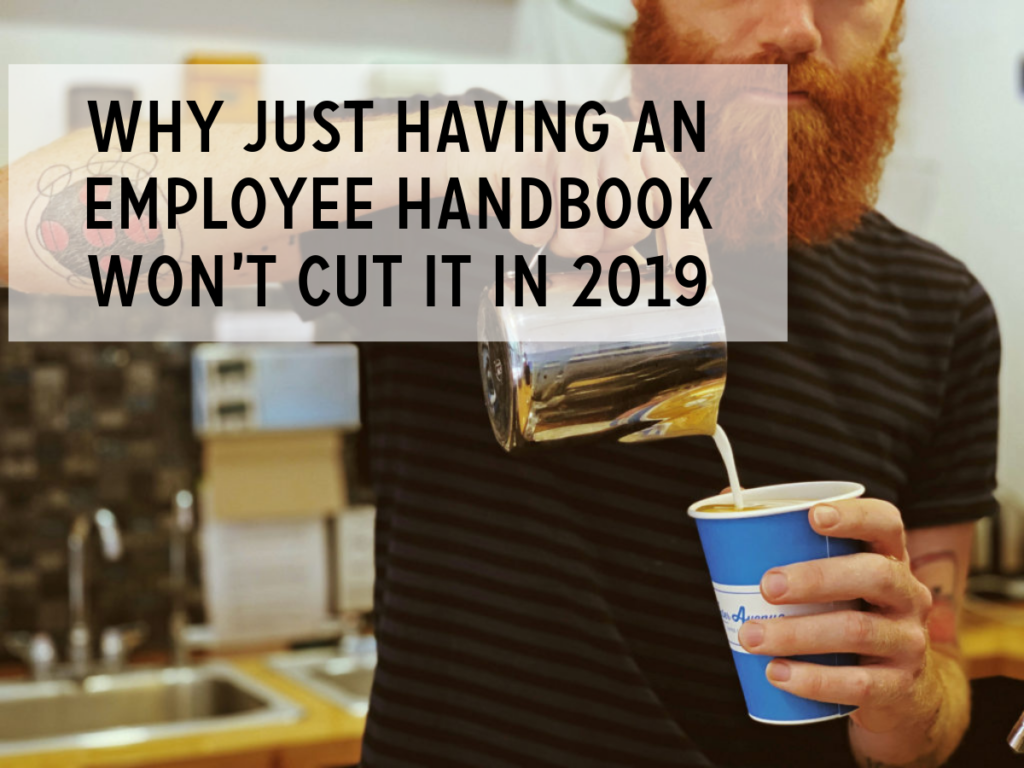Say you’re about to open a coffee shop or maybe even just opened. It’s a busy time and you’re making sure everything is just right. One of the biggest mistakes that new coffee shop owners make is taking employee development for granted. Everyone talks about employee handbooks (which are vital), but having a well thought out operations manual is often the make-or-break step as you
- develop your brand
- hire new employees
- start seeing regulars.
Simply put: Your employee handbook tells your employees about policies, but your operations manual gives your employee resources to actually do the job.

What is an Employee Handbook?
An employee handbook is used to inform employees of what’s expected of them and what they can expect from their employer in a general sense. A good employee handbook will include sections on standards of conduct, pay structures, and policies on breaks, outside employment, and attendance. A thorough employee handbook lays out the expectations and rules of a workplace clearly, and acts as a fallback if any rules are violated. For more information on the ins and outs of employee handbooks, see our previous article.
What is an Operations Manual?
An operations manual goes farther than an employee handbook, and is often even more personal to the specific business it is created for. Creating an operations manual can take days, sometimes weeks of work because of just how many things must be outlined clearly. Your operations manual should contain information on every task an employee is expected to do, especially standards of making drinks or interacting with customers. Your operations manual also serves to help your employees understand your business and vision. Some policies or expectations may seem silly when first presented, but the operations manual is the place to explain why these policies exist and how they contribute to the business. A truly great operations manual will also get an employee excited to work at a company. Your employees will often be the ambassadors of your brand, so it is vital they understand and want to promote it.
Why do you need both?
Your employee handbook and your operations manual should complement each other, but they serve very different purposes. Both can act as a reference to bring up in situations where an employee isn’t meeting expectations, but your operations manual will be the most useful for day to day issues. You can think of the employee handbook as a necessary but bland document that covers you legally, but the operations manual is where you get to have fun and actually talk about the business.

How do you make an operations manual?
A good operations manual consists of four essential parts: training, shift duties, beverage guides, and maintaining equipment. These are by no means the only aspects to a training manual, but they are the four most important things to convey to your employees in order to create consistent experiences for all your customers.
Training
Hiring new employees is great: they can bring a different perspective into the workplace and a new energy to the team. These new individuals are valuable, but their potentials can easily be lost in the shuffle of disorganization and chaos if they aren’t properly prepared for their first day on the job. The customers that come into your coffee business are, whether consciously or unconsciously, watching your employees’ every move. It becomes noticeable and bothersome very quickly when you notice that an employee doesn’t seem like they know what they’re doing. A drink in a confused employee’s hand doesn’t instill a whole lot of confidence in the customer that they’ll be receiving the quality drink they ordered in the first place.

This is why proper training and checklists are so important to the development of your barista’s skills and techniques. Consistency is key in all stages of an employee’s journey throughout your coffee business, from the first introduction, and all the way into working solo shifts. There must be a sense of accountability between managers and trainees to document that each step of the training process was completed before moving onto the next step. This is also why communication is important; employees need to feel comfortable and able to ask questions if they’re confused about something their trainer is teaching them. Without it, major milestones of a barista’s training may be missed and your customers will suffer.
Each step in a barista’s training process should be documented and discussed before moving on. If not, your employees will be on different pages, confused, and giving potential customers an inconsistent experience. A successful coffee shop is one where every employee goes into their first shift feeling prepared with all of the tools they’ll need to provide the best experience for each customer.
Shift Duties
Once the proper training steps have been taken, your job isn’t done! From there on out, it’s all about maintaining a high standard for what happens each shift. Checklists should be utilized in this stage, too. Opening tasks, mid-shift tasks, closing tasks, cleaning, and other daily duties all need to be documented. If you don’t hold your employees accountable, laziness is sometimes inevitable. Things will stop getting done if people aren’t held to a standard of checking tasks off once they’re done and then signing their name/initials to ensure accountability.
This system makes spot-checking easy for managers to go through and see who checked off on what duties. Say a barista checked and signed off that they had swept the floor around the bar and register area at 10:30am. When the manager walks in five minutes later, there should be a noticeable difference in the cleanliness of the floor. If there’s not, it becomes easy to keep that specific employee accountable for their actions, or lack thereof.
These checklists are designed to keep consistency in routines and to ensure an amazing experience each time a customer walks into your shop. There should never be any doubt about what type of experience you’ll have, how clean it will be, how friendly the staff is, and how quickly you receive your order.
Beverage Guides
Not only is it important to have consistency in employee behaviors and interactions with their workspace and customers, but also for them to be producing quality drinks every time. This is where detailed guides come in handy so that you can use these to train your employees, as well as to have them posted around the bar area for employees to refer back to if need be. A proper beverage guide will provide detailed instructions on how to uniformly make all typical coffee bar beverages, notes on syrup and sauce portions, iced drink preparation, non-coffee beverage preparation, and a brewed coffee guide.
These guides ensure each employee has the same knowledge of how to make each drink so the customer gets the exact same preparation of it no matter who is working that given day. Consistency in drink-making is a crucial step in developing regulars who continue to come back for more. Customers have expectations when they walk into your shop and it’s your job to make sure that your employees are meeting and exceeding those every time. The barista who’s working the bar that day shouldn’t have any effect on the quality of drinks that are being made.

By having a team who is committed to the standard of consistent, well-made coffee beverages, you’ll be well on your way to success already. But remember, it takes an entire team to win a game. Everyone needs to be on the same page and on their A-game at all times to make sure that a quality product gets to each customer. One bad egg can tarnish your entire reputation as a coffee business; that’s why it is important to take special care when choosing and training your team of baristas.
Maintaining Machinery
Something that goes unnoticed by many employees is that the machines don’t automatically clean themselves once the doors are locked for the night. Improper care of your expensive machinery will cause you a great amount of headache and pain in the long run when you realize they haven’t been cleaned properly the whole time they’ve sat on your cafe counters. While quality equipment hopefully will last a long while, its lifetime depends on how properly and often it’s maintained.
Machinery protocol comes into play when teaching your employees how to properly take care of the gear that’s being used daily. It’s not safe to assume that your employees know that these steps need to be taken because some of the machines are complex and cleaning them is difficult to do by intuition. Make sure your employees feel comfortable with the way each machine works and how to ensure it continues to work well.
Depending on the equipment you’re using, this section may be rather simple or quite involved. With this being said, it’s crucial to remember to make the steps to clean and maintain each piece of equipment detailed and easy-to-read. These instructions should include batch brewer cleaning protocol, backflushing and daily maintenance of the espresso machine, and maintenance of the espresso steam wands. Don’t let an unclean and neglected piece of equipment cost you valuable business because your shots are off par or your milk isn’t steaming correctly.
Working For Longevity
Ultimately, your operations manual is there to ensure a consistently positive experience for your customers, and help you employees feel confident while doing their job. Regulars are the lifeblood of any coffee business. If your coffee business can establish a core base of loyal customers, you are already more than halfway there in running a successful, long-term gig. Each and every customer that walks into your shop has the potential to make you thousands of dollars in your business’s lifetime, so don’t squander that opportunity! You may ask, “Well, how do I get that type of customer loyalty?” The answer is simple: a well-built operations manual.
There’s no way around it; creating a great operations manual is hard. To save you time and headache, we offer a fully customizable operations manual designed specifically for coffee businesses.


